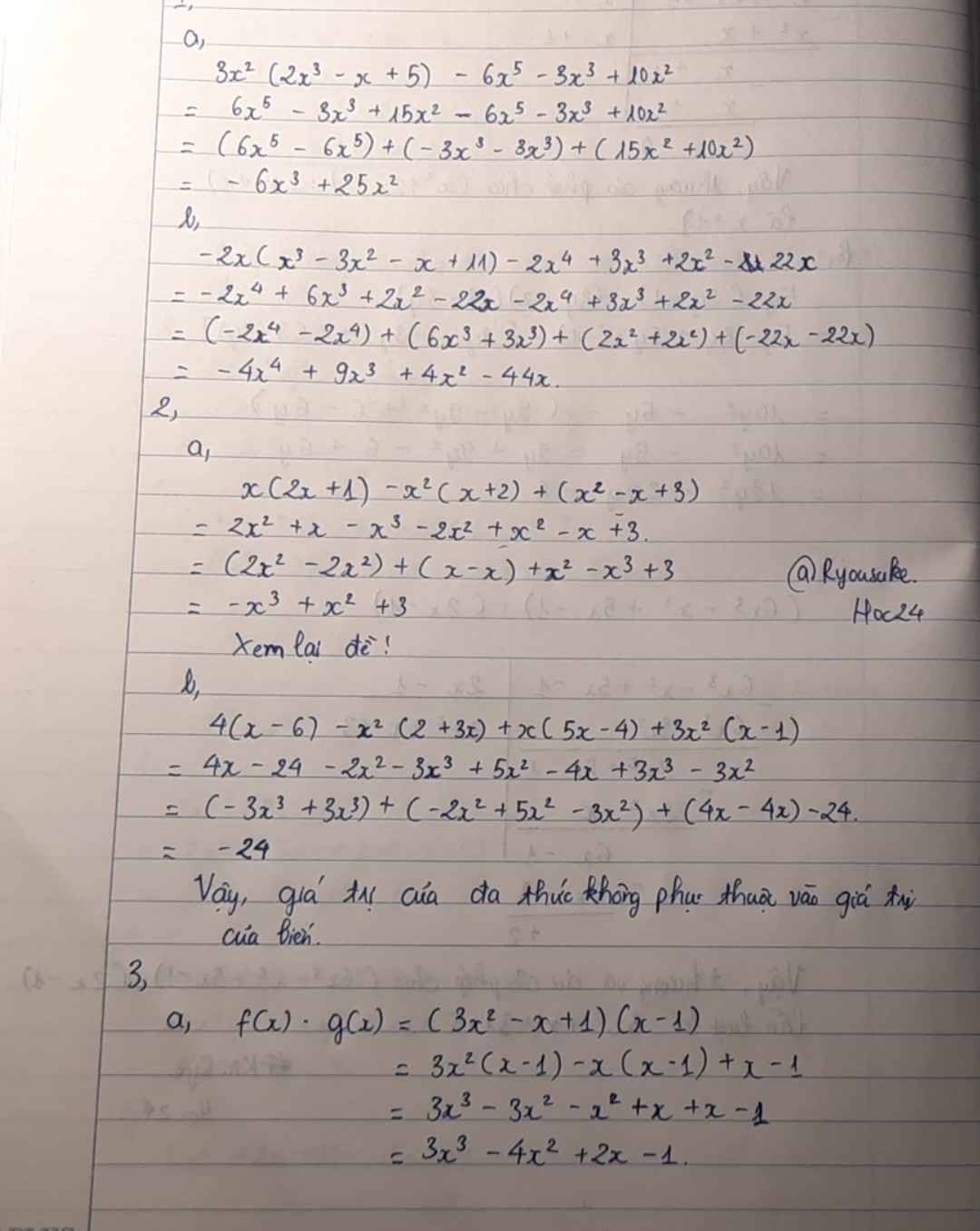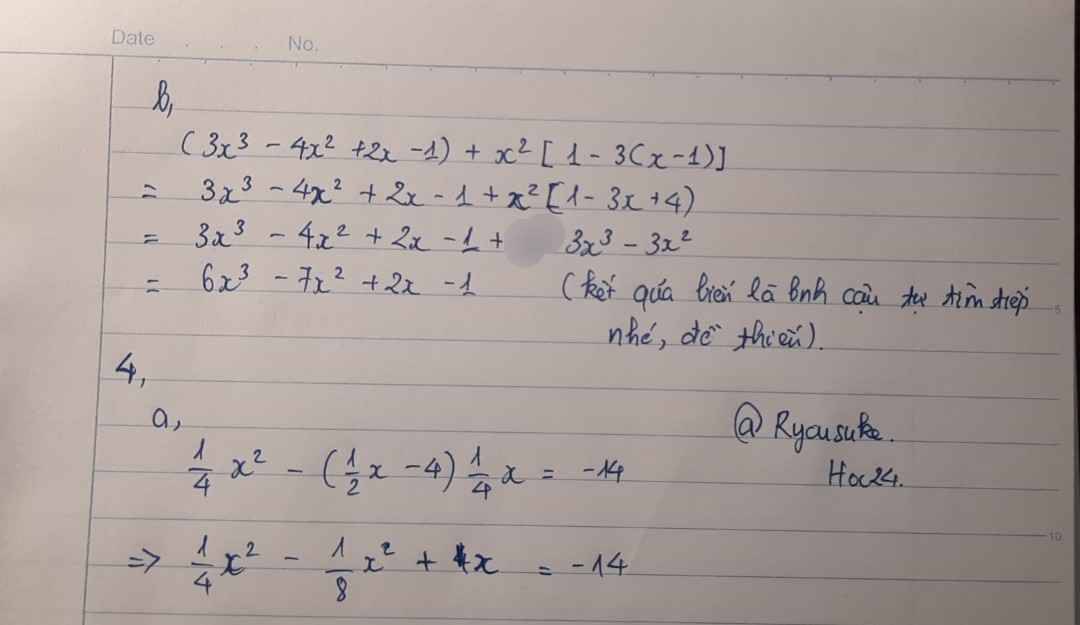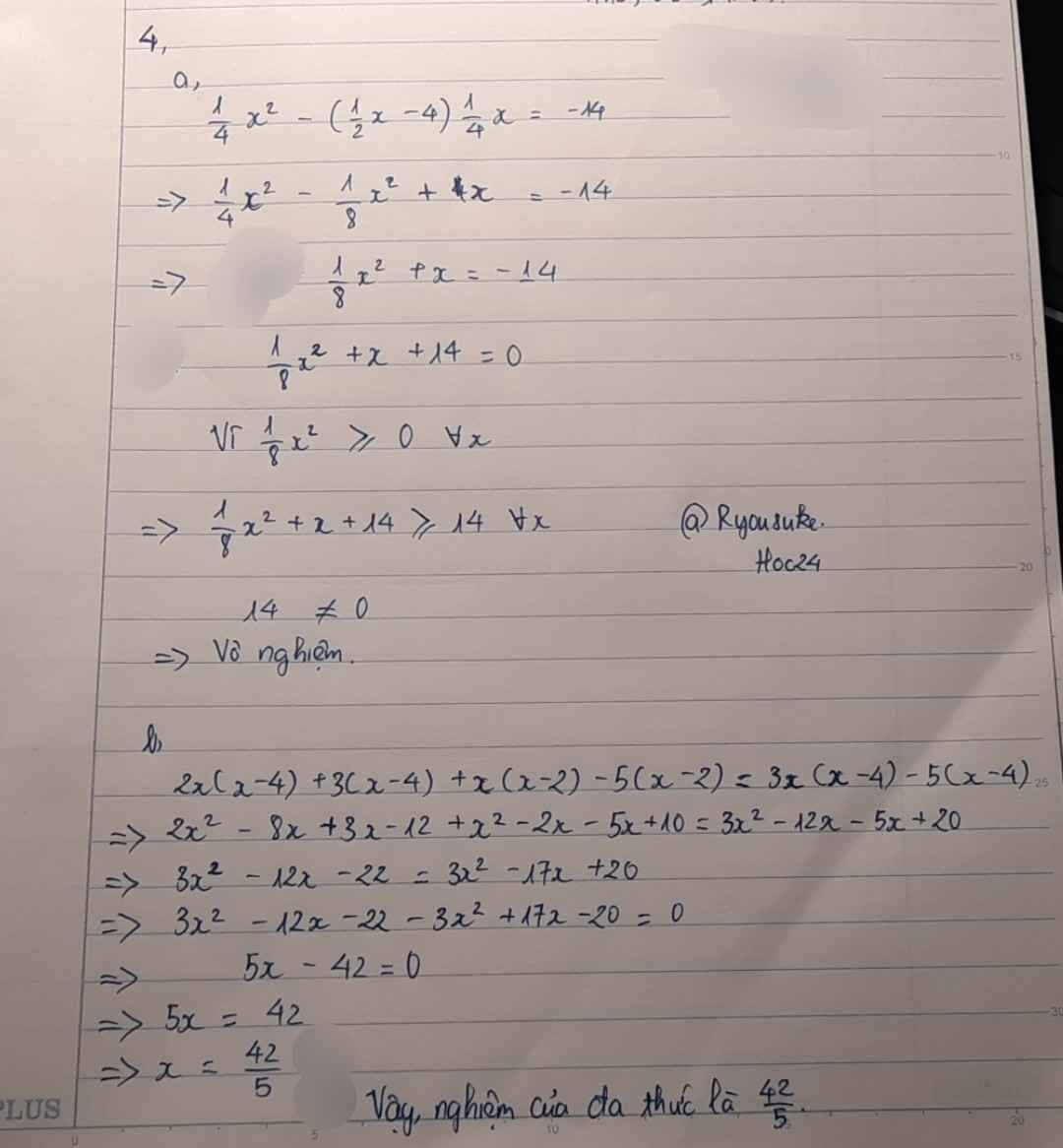Hãy nhập câu hỏi của bạn vào đây, nếu là tài khoản VIP, bạn sẽ được ưu tiên trả lời.

Bài 1:
a) \(3x^2\left(2x^3-x+5\right)-6x^5-3x^3+10x^2\)
\(=6x^5-3x^3+10x^2-6x^5-3x^3+10x^2\)
\(=10x^2+10x^2\)
\(=20x^2\)
b) \(-2x\left(x^3-3x^2-x+11\right)-2x^4+3x^3+2x^2-22x\)
\(=-2x^4+6x^3+2x^2-22x-2x^4+3x^3+2x^2-22x\)
\(=-4x^4+9x^3+4x^2-44x\)

Bài 1: (1/2x - 5)20 + (y2 - 1/4)10 < 0 (1)
Ta có: (1/2x - 5)20 \(\ge\)0 \(\forall\)x
(y2 - 1/4)10 \(\ge\)0 \(\forall\)y
=> (1/2x - 5)20 + (y2 - 1/4)10 \(\ge\)0 \(\forall\)x;y
Theo (1) => ko có giá trị x;y t/m
Bài 2. (x - 7)x + 1 - (x - 7)x + 11 = 0
=> (x - 7)x + 1.[1 - (x - 7)10] = 0
=> \(\orbr{\begin{cases}\left(x-7\right)^{x+1}=0\\1-\left(x-7\right)^{10}=0\end{cases}}\)
=> \(\orbr{\begin{cases}x-7=0\\\left(x-7\right)^{10}=1\end{cases}}\)
=> x = 7
hoặc : \(\orbr{\begin{cases}x-7=1\\x-7=-1\end{cases}}\)
=> x = 7
hoặc : \(\orbr{\begin{cases}x=8\\x=6\end{cases}}\)
Bài 3a) Ta có: (2x + 1/3)4 \(\ge\)0 \(\forall\)x
=> (2x +1/3)4 - 1 \(\ge\)-1 \(\forall\)x
=> A \(\ge\)-1 \(\forall\)x
Dấu "=" xảy ra <=> 2x + 1/3 = 0 <=> 2x = -1/3 <=> x = -1/6
Vậy Min A = -1 tại x = -1/6
b) Ta có: -(4/9x - 2/5)6 \(\le\)0 \(\forall\)x
=> -(4/9x - 2/15)6 + 3 \(\le\)3 \(\forall\)x
=> B \(\le\)3 \(\forall\)x
Dấu "=" xảy ra <=> 4/9x - 2/15 = 0 <=> 4/9x = 2/15 <=> x = 3/10
vậy Max B = 3 tại x = 3/10

a: Ta có: \(x\left(x^2+x+1\right)-x^2\left(x+1\right)-x+5\)
\(=x^3+x^2+x-x^3-x^2-x+5\)
=5
b: Ta có: \(x\left(2x+1\right)-x^2\left(x+2\right)+x^3-x+3\)
\(=2x^2+x-x^3-2x^2+x^3-x+3\)
=3
c: Ta có: \(4\left(6-x\right)+x^2\left(3x+2\right)-x\left(5x-4\right)+3x^2\left(1-x\right)\)
\(=24-4x+3x^3+2x^2-5x^2+4x+3x^2-3x^3\)
=24

\(a\\ -5x^2+3x.\left(x+2\right)=-5x^2+3x^2+6x=-2x^2+6x\\ b\\ -2x.\left(1-x^2\right)-2x^3=-2x+2x^3-2x^3=-2x\\ c\\ 4x.\left(x-1\right)-4.\left(x^2+2x-1\right)\\ =4x^2-4x-4x^2-8x+4=-12x+4\)
\(d\\ 6x^3-2x^2.\left(-x^2-3x\right)=6x^3+2x^4+6x^3=2x^4+12x^3\\ e\\ 3x.\left(x-1\right)-\left(1+2x\right).5x\\ =3x^2-3x-5x-10x^2=-7x^2-8x\\ f\\ -5x^2-\left(x-6\right).\left(-2x^2\right)=-5x^2+2x^3-12x^2=2x^3-17x^2\)

3a)Vì A là số nguyên
=>\(3n+9⋮n-4=>3n-12+21⋮n-4=>3.\left(n-4\right)+21⋮n-4\)
Mà \(\text{3 . (n - 4)}⋮n-4\)
=>\(21⋮n-4=>n-4\inƯ\left(21\right)=\left\{-21;-7;-3;-1;1;3;7;21\right\}\)
(Vì n là số nguyên => n - 4 là 1 số nguyên)
=>\(n\in\left\{-17;-3;1;3;5;9;11;25\right\}\)
Ta có bảng sau:
| n | -17 | -3 | 1 | 3 | 5 | 9 | 11 | 25 |
| 3n + 9 | -42 | 0 | 12 | 18 | 24 | 36 | 42 | 84 |
| n - 4 | -21 | -7 | -3 | -1 | 1 | 3 | 7 | 21 |
| \(A=\dfrac{3n+9}{n-4}\) | 2 | 0 | -4 | -18 | 24 | 12 | 6 | 4 |
Vậy.....
b)Vì B là số nguyên
=>\(2n-1⋮n+5=>2n+10-11⋮n+5=>2\left(n+5\right)-11⋮n+5\)
Mà \(\text{2 ( n + 5)}⋮n+5\)
=>\(11⋮n+5=>n+5\in\left\{-11;-1;1;11\right\}\)
(Vì n là số nguyên=> n + 5 là số nguyên)
=> \(n\in\left\{-16;-6;-4;6\right\}\)
Ta có bảng sau:
| n | -16 | -6 | -4 | 6 |
| 2 n - 1 | -33 | -13 | -9 | 11 |
| n + 5 | -11 | -1 | 1 | 11 |
| \(B=\dfrac{2n-1}{n+5}\) | 3 | 13 | -9 |
1 |
Vậy.......

Bài 1: a/b=b/c=c/a chứ không phải c/d
áp dụng tính chất dãy tỉ số bằng nhau, ta có:
a/b=b/c=c/a=(a+b+c)/(b+c+a)=1
a/b=1 => a=b
b/c=1 => b=c
Vậy a=b=c



Xin lỗi, mình sai đề :
a) (x2 - 1) . ( x2 - 4) < 0
\(\text{b) }2+4+6+...+2x=210\\ \Leftrightarrow2\left(1+2+3+...+x\right)=210\\ \Leftrightarrow1+2+3+...+x=105\\ \Leftrightarrow1+2+3+...+x=1+2+3+...+14\\\Leftrightarrow\left(1+2+3+...\right)+x=\left(1+2+3+...\right)+14\\ \Leftrightarrow x=14 \)
Vậy \(x=14\)